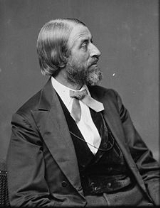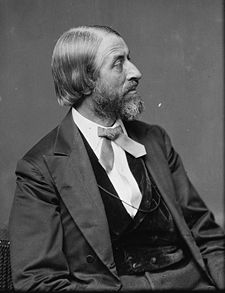
Ainsworth Rand Spofford
Encyclopedia
Ainsworth Rand Spofford (12 September 1825 – 11 August 1908) was an American journalist and publisher. He was the sixth Librarian of the United States Congress
from 1864 to 1897.
 Spofford was born in Gilmanton, New Hampshire
Spofford was born in Gilmanton, New Hampshire
. Ill health prevented him from attending Amherst College
. He instead, at age 19, moved to Cincinnati, Ohio
, where he became a bookseller, publisher, and newspaper man. In 1851, in response to the Fugitive Slave Law, he published the pamphlet The Higher Law, Tried by Reason and Authority which argued that "Injustice is the only treason; no law can legalize it, no constitution can sanction it." Readers included Ralph Waldo Emerson, who shared Spofford's antislavery principles. In 1859 Spofford became associate editor of the Cincinnati Commercial. He was also active in Republican party politics and was a delegate to the nominating convention of John Charles Frémont in 1856.
While in Washington D.C. in 1861, shortly after reporting on the First Battle of Bull Run
for The Cincinnati Commercial, Spofford accepted the position of Chief Assistant Librarian of Congress. Once Spofford learned of the retirement of Librarian of Congress John G. Stephenson, Spofford gathered enough political endorsements for the job which later led President Abraham Lincoln
to promote Spofford to the post of Librarian of Congress in 1864.
began as a comprehensive collection under the donation of Thomas Jefferson
in 1814. However, the Library of Congress shifted to a very domestic collection management program until the end of the Civil War
. Spofford adhered to the Jeffersonian belief that a “democratic form of government depended on a comprehensive base of knowledge and information.” That has been the legacy of Spofford, and one that each Librarian of Congress since has built upon.
Spofford is generally credited with overseeing the expansion of the Library from a Congressional resource into a national institution. During Spofford's tenure, the Library expanded from over 60,000 items to more than one million. His hopes were to follow the great library models of Europe
. A model in which "the library would be a comprehensive collection of the literature of the nation."
Beginning in the 1830s, the Library of Congress began to receive foreign governmental documents and publications. During the late 1860s, Spofford convinced Congress to allow the Library of Congress to become the repository for international documents. Spofford often received congressional approval by reminding them "there is almost no work, within the vast range of literature and science, which may not at some time prove useful to the legislature of a great nation." Furthermore, the Smithsonian Library transferred their entire collection to the Library of Congress.
Spofford's vision was to turn the Library of Congress into an "American national library". He felt that Americans deserved a national collection because America was a "Republic, which rests upon popular intelligence." One of Spofford's greatest feats was the copyright law of 1870. It further centralized the collection of the Library of Congress. It stipulated that two copies of every "book pamphlet, map, print, photograph, and piece of music registered for copyright be deposited in the Library, a requirement that certainly would have met with Jefferson's approval." Spofford knew that this massive influx of materials would also force Congress to appropriate funds for a new building, which they finally agreed to in 1886. This building became a national monument immediately, and is now known as the Thomas Jefferson Building.
Spofford stepped aside in favor of a younger administrator, John Russell Young
, and returned to his old post of Chief Assistant Librarian, where he remained until his death.
United States Congress
The United States Congress is the bicameral legislature of the federal government of the United States, consisting of the Senate and the House of Representatives. The Congress meets in the United States Capitol in Washington, D.C....
from 1864 to 1897.
Early years

Gilmanton, New Hampshire
Gilmanton is a town in Belknap County, New Hampshire, United States. The population was 3,777 at the 2010 census. Gilmanton includes the villages of Gilmanton Corner and Gilmanton Ironworks...
. Ill health prevented him from attending Amherst College
Amherst College
Amherst College is a private liberal arts college located in Amherst, Massachusetts, United States. Amherst is an exclusively undergraduate four-year institution and enrolled 1,744 students in the fall of 2009...
. He instead, at age 19, moved to Cincinnati, Ohio
Cincinnati, Ohio
Cincinnati is a city in the U.S. state of Ohio. Cincinnati is the county seat of Hamilton County. Settled in 1788, the city is located to north of the Ohio River at the Ohio-Kentucky border, near Indiana. The population within city limits is 296,943 according to the 2010 census, making it Ohio's...
, where he became a bookseller, publisher, and newspaper man. In 1851, in response to the Fugitive Slave Law, he published the pamphlet The Higher Law, Tried by Reason and Authority which argued that "Injustice is the only treason; no law can legalize it, no constitution can sanction it." Readers included Ralph Waldo Emerson, who shared Spofford's antislavery principles. In 1859 Spofford became associate editor of the Cincinnati Commercial. He was also active in Republican party politics and was a delegate to the nominating convention of John Charles Frémont in 1856.
While in Washington D.C. in 1861, shortly after reporting on the First Battle of Bull Run
First Battle of Bull Run
First Battle of Bull Run, also known as First Manassas , was fought on July 21, 1861, in Prince William County, Virginia, near the City of Manassas...
for The Cincinnati Commercial, Spofford accepted the position of Chief Assistant Librarian of Congress. Once Spofford learned of the retirement of Librarian of Congress John G. Stephenson, Spofford gathered enough political endorsements for the job which later led President Abraham Lincoln
Abraham Lincoln
Abraham Lincoln was the 16th President of the United States, serving from March 1861 until his assassination in April 1865. He successfully led his country through a great constitutional, military and moral crisis – the American Civil War – preserving the Union, while ending slavery, and...
to promote Spofford to the post of Librarian of Congress in 1864.
Library of Congress
The Library of CongressLibrary of Congress
The Library of Congress is the research library of the United States Congress, de facto national library of the United States, and the oldest federal cultural institution in the United States. Located in three buildings in Washington, D.C., it is the largest library in the world by shelf space and...
began as a comprehensive collection under the donation of Thomas Jefferson
Thomas Jefferson
Thomas Jefferson was the principal author of the United States Declaration of Independence and the Statute of Virginia for Religious Freedom , the third President of the United States and founder of the University of Virginia...
in 1814. However, the Library of Congress shifted to a very domestic collection management program until the end of the Civil War
American Civil War
The American Civil War was a civil war fought in the United States of America. In response to the election of Abraham Lincoln as President of the United States, 11 southern slave states declared their secession from the United States and formed the Confederate States of America ; the other 25...
. Spofford adhered to the Jeffersonian belief that a “democratic form of government depended on a comprehensive base of knowledge and information.” That has been the legacy of Spofford, and one that each Librarian of Congress since has built upon.
Spofford is generally credited with overseeing the expansion of the Library from a Congressional resource into a national institution. During Spofford's tenure, the Library expanded from over 60,000 items to more than one million. His hopes were to follow the great library models of Europe
Europe
Europe is, by convention, one of the world's seven continents. Comprising the westernmost peninsula of Eurasia, Europe is generally 'divided' from Asia to its east by the watershed divides of the Ural and Caucasus Mountains, the Ural River, the Caspian and Black Seas, and the waterways connecting...
. A model in which "the library would be a comprehensive collection of the literature of the nation."
Beginning in the 1830s, the Library of Congress began to receive foreign governmental documents and publications. During the late 1860s, Spofford convinced Congress to allow the Library of Congress to become the repository for international documents. Spofford often received congressional approval by reminding them "there is almost no work, within the vast range of literature and science, which may not at some time prove useful to the legislature of a great nation." Furthermore, the Smithsonian Library transferred their entire collection to the Library of Congress.
Spofford's vision was to turn the Library of Congress into an "American national library". He felt that Americans deserved a national collection because America was a "Republic, which rests upon popular intelligence." One of Spofford's greatest feats was the copyright law of 1870. It further centralized the collection of the Library of Congress. It stipulated that two copies of every "book pamphlet, map, print, photograph, and piece of music registered for copyright be deposited in the Library, a requirement that certainly would have met with Jefferson's approval." Spofford knew that this massive influx of materials would also force Congress to appropriate funds for a new building, which they finally agreed to in 1886. This building became a national monument immediately, and is now known as the Thomas Jefferson Building.
Spofford stepped aside in favor of a younger administrator, John Russell Young
John Russell Young
John Russell Young was an American journalist, author, diplomat, and the seventh Librarian of the United States Congress from 1897 to 1899.-Biography:...
, and returned to his old post of Chief Assistant Librarian, where he remained until his death.

